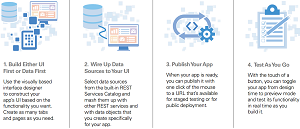News
Oracle Introduces Low-Code Development Platform in the Cloud
- By David Ramel
- September 22, 2016
Among the host of cloud technology news items coming from Oracle Corp.'s OpenWorld conference was this tidbit of special interest to "citizen" mobile developers: a new cloud-based, low-code development platform in the making.
Called Project Visual Code, it joins a crowded space that just keeps growing, with entries ranging from powerhouses like Microsoft and IBM to smaller specialists like Mendix and even academic institutions like MIT.
All are based on the same premise: Enterprise app demand outstrips the supply, which is hindered by a lack of skilled (and highly paid) professional developers. Thus has risen the low-code (or no-code, or DIY, or visual WYSIWYG, or drag-and-drop and so on) movement.
The approach has become such a force in the enterprise development world that analyst firm Forrester Research Inc. started tracking the space in 2014 and in April published the Forrester Wave: Low-Code Development Platforms, Q2 2016 report (provided by vendor OutSystems). The firm identified 42 platform vendors and five industry segments in its research.
Oracle, in announcing Project Visual Code, quoted from the Forrester report.
"More than ever before, AD&D [application development and delivery] pros must obsess over their user interface designs. Today, customers and employees expect to access applications from a wide range of devices, putting additional pressure on developers. Low-code vendors employ familiar drag-and-drop, WYSIWYG techniques to speed user interface (UI) creation," wrote Forrester analysts John Rymer and Clay Richardson.
According to Oracle, Project Visual Code fits that bill perfectly.
"The real-time enterprise has made it necessary for organizations to rethink application development in order to keep up with rapidly changing demands," the company said in a statement.
"IT teams are often stuck with a backlog of work, which means the business can't always get applications delivered quickly enough to capitalize on new opportunities presented by digital transformation," the statement continued. "To help solve this challenge and democratize app development, Oracle has introduced Project Visual Code, which enables business users to quickly and easily develop and extend enterprise applications."
The project comprises five parts, but not all of them are in place yet. The components include: a Builder visual tool for creating and hosting apps; a modern, responsive UI design system; UI component architecture based on the company's open source JavaScript Extension Toolkit (Oracle JET) that can be used to create reusable components for mobile and Web apps; business objects derived from REST-based services or newly created objects based on custom data requirements; and an application marketplace where developers can find functional UI components or complete apps to use in their own work -- or share or sell their own creations.
 [Click on image for larger view.]
The Builder Component of Project Visual Code (source: Oracle Corp.)
[Click on image for larger view.]
The Builder Component of Project Visual Code (source: Oracle Corp.)
The Builder component of the project was announced in a February blog post titled Oracle Application Builder Cloud Service - Citizen Developers Rejoice. Oracle shortened that name to ABCS in the post.
"With ABCS users visually design Web applications through a WYSWYIG page editor dragging and dropping UI components onto pages, and connecting these UI components to data objects," the February post said. "These data objects can be created on the fly as an integral part of the interface development. Users can create applications with multiple pages, multiple related data objects and rich UIs."
To complete Project Visual Code, a future version of Builder will integrate with the same environment that provides the mobile capabilities found in the company's Oracle Mobile Application Accelerator (Oracle MAX), Oracle exec Bill Pataky told ADTMag. Oracle MAX, part of the Oracle Mobile Cloud Service, "allows anyone to quickly create, test, and publish sophisticated cross-platform mobile apps. No coding required."
Yet other work that needs to be done to complete the project involves a modification of the Oracle Cloud Marketplace to act as a repository for reusable, shareable and sellable UI components.
"With the new Project Visual Code, customers will be able to utilize a library of responsive user interface components and complete applications -- made available in the Oracle Cloud Marketplace -- to add features that can be embedded directly into their own applications, environments or even existing Oracle Cloud applications," the company said in its statement this week.
"With minimal coding needed and intuitive visual design capabilities, business users and citizen developers can easily create the applications they need on their own, with little to no involvement from their IT department."
However, that component isn't in place yet. "The marketplace/catalog for components is something that will come in the future," Pataky told ADTMag in an e-mail. "We've announced the full platform but this piece remains to be released. The technology for creating the UI components is available today in the latest release of the open source Oracle JET. We have some samples there, and people can start developing their components and using them directly. We are working on creating the spaces in the marketplace for hosting such components in a future version."
Like other low-code tools, Project Visual Code isn't just for the "citizen developer" market, as its functionality can be put to use by dev pros who need to extend apps with custom coding for certain cases.
"Project Visual Code enables me to create a complete application including database and rich responsive UI in minutes without writing a single line of code," the company quoted Luc Bors at customer eProseed as saying. "I like the fact that as a professional developer, I can add more advanced capabilities with a bit of JavaScript code."
More Coverage of Low-Code Tools
About the Author
David Ramel is an editor and writer at Converge 360.